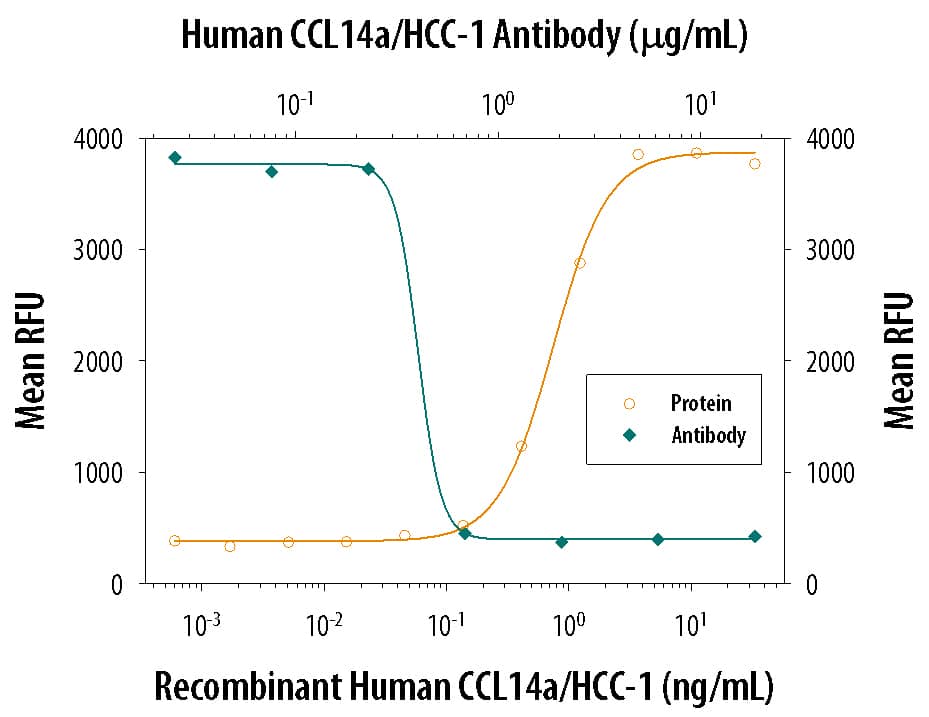Human CCL14a/HCC-1 Antibody
R&D Systems, part of Bio-Techne | Catalog # AF-324-PB


Key Product Details
Species Reactivity
Applications
Label
Antibody Source
Product Specifications
Immunogen
Thr20-Asn93
Accession # Q16627
Specificity
Clonality
Host
Isotype
Endotoxin Level
Scientific Data Images for Human CCL14a/HCC-1 Antibody
Chemotaxis Induced by CCL14a/HCC‑1 and Neutral-ization by Human CCL14a/HCC‑1 Antibody.
Recombinant Human CCL14a/HCC-1 (Catalog # 1578-HC) chemoattracts the BaF3 mouse pro-B cell line transfected with human CCR1 in a dose-dependent manner (orange line). The amount of cells that migrated through to the lower chemotaxis chamber was measured by Resazurin (Catalog # AR002). Chemotaxis elicited by Recombinant Human CCL14a/HCC-1 (10 ng/mL) is neutralized (green line) by increasing concentrations of Goat Anti-Human CCL14a/ HCC-1 Antigen Affinity-purified Polyclonal Antibody (Catalog # AF-324-PB). The ND50 is typically 0.15-0.75 µg/mL.Applications for Human CCL14a/HCC-1 Antibody
Western Blot
Sample: Recombinant Human CCL14a/HCC-1 aa 20-93 (Catalog # 324-HC)
Neutralization
Formulation, Preparation, and Storage
Purification
Reconstitution
Formulation
Shipping
Stability & Storage
- 12 months from date of receipt, -20 to -70 °C as supplied.
- 1 month, 2 to 8 °C under sterile conditions after reconstitution.
- 6 months, -20 to -70 °C under sterile conditions after reconstitution.
Background: CCL14a/HCC-1
HCC-1 (Hemofiltrate CC Chemokine-1) was originally isolated from the hemofiltrate of human patients with chronic renal failure (1). It belongs to the CC chemokine superfamily and has been designated CCL14a. HCC-1/CCL14a cDNA encodes a 93 amino acid (aa) residue precursor with a 19 aa signal peptide that is cleaved to form the 74 aa secreted protein (aa 20‑93). By alternative splicing, a second longer isoform named HCC-3/CCL14b, which includes sequences from exon 3, also exists (2). HCC-1/CCL14a is expressed constitutively in various normal tissues including spleen, liver, muscle, gut and bone marrow. It circulates at nanomolar concentrations in human plasma. Different post-translationally modified HCC-1/CCL14a, including O-glycosylated and N-terminally truncated variants of HCC‑1/CCL14a, have been identified (3, 4). Whereas the 74 aa peptide is a weak CCR1 agonist, the proteolytically processed, truncated HCC‑1/CCL14a (aa 28‑93) is a highly potent agonist of CCR1, CCR5 and to a lesser extent, CCR3. HCC-1/CCL14a (aa 28‑93) promotes chemotaxis of T lymphocytes, monocytes and eosinophils, and inhibits infection of M-tropic human immunodeficiency virus type 1. Activation of the HCC-1/CCL14a precursor to active peptide is mediated by the urokinase type plasminogen activator or plasmin (5).
References
- Schulz-Knappe, P. et al. (1996) J. Exp. Med. 183:295.
- Forssmanns, U. et al. (2001) J. Leukocyte Biology 70:357.
- Richter, R. et al. (2000) Biochemistry 39:10799.
- Munch, J. et al. (2002) Antimicrob. Agents Chemother. 46:982.
- Vakili, J. et al. (2001) J. Immunol. 167:3406.
Alternate Names
Entrez Gene IDs
Gene Symbol
UniProt
Additional CCL14a/HCC-1 Products
Product Documents for Human CCL14a/HCC-1 Antibody
Product Specific Notices for Human CCL14a/HCC-1 Antibody
For research use only